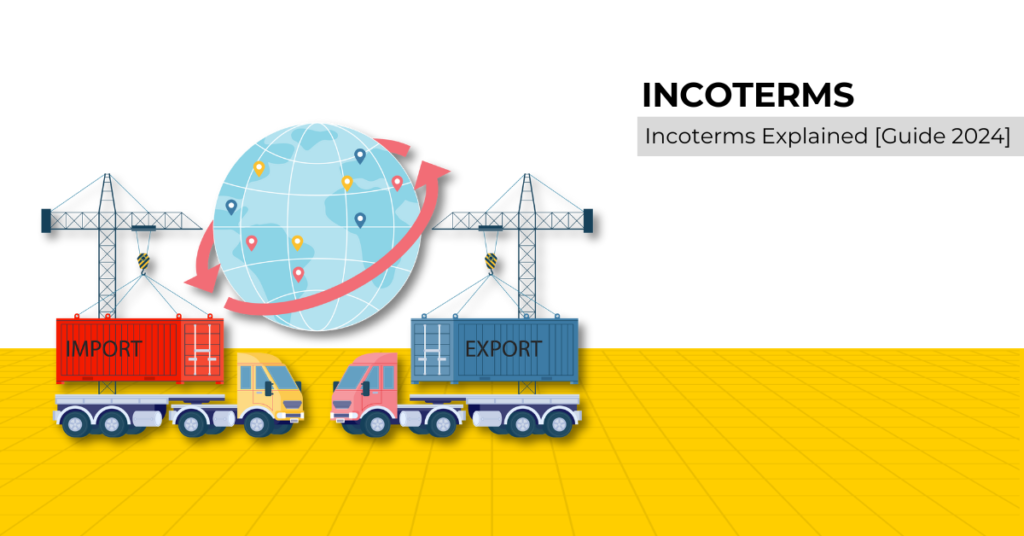History of Incoterms
- Before Incoterms
- In the early 20th century, international trade faced significant challenges due to varying laws and terms across countries and regions, leading to confusion and disputes.
- Emergence of Incoterms (1936)
- The first version, published by the ICC in 1936, included six terms mainly designed for maritime trade.
- Updated Versions
- 1953: Added terms for rail and road transport.
- 1980: Adapted to air and containerized transport.
- 2000: Simplified and created new terms.
- 2020: Latest version, focusing on clarification and optimization.
Categories of Incoterms (2020)
Group E: Delivery at the Seller’s Premises
- EXW (Ex Works)
- The seller delivers goods at their premises.
- The buyer assumes all costs and risks from the seller’s location to the final destination.
Group F: Delivery Without Freight Paid
- FCA (Free Carrier)
- The seller delivers goods to a carrier designated by the buyer at a specified location.
- FAS (Free Alongside Ship) (Maritime Transport)
- The seller delivers goods alongside the ship at the port. The buyer is responsible for loading and maritime transport costs.
- FOB (Free on Board) (Maritime Transport)
- The seller delivers goods onto the ship. Risks and costs transfer to the buyer after loading.
Group C: Delivery with Freight Paid
- CFR (Cost and Freight) (Maritime Transport)
- The seller pays shipping costs to the destination port. Risks transfer to the buyer upon loading.
- CIF (Cost, Insurance, and Freight) (Maritime Transport)
- Similar to CFR, but the seller also provides insurance for the goods up to the destination port.
- CPT (Carriage Paid To)
- The seller covers transport costs to the destination. Risks transfer to the buyer upon delivery to the carrier.
- CIP (Carriage and Insurance Paid To)
- Similar to CPT, but the seller also covers insurance costs.
Group D: Delivery at Destination
- DAP (Delivered at Place)
- The seller delivers goods to a specified location, excluding customs duties and clearance costs.
- DPU (Delivered at Place Unloaded)
- Similar to DAP, but the seller is responsible for unloading goods.
- DDP (Delivered Duty Paid)
- The seller delivers goods to the specified location, covering all costs, including customs duties and taxes.
Why Are Incoterms Important?
- Reduce Disputes: Clear definition of each party’s obligations.
- Transparency in Costs: Specify responsibilities for transport, insurance, and customs.
- Facilitate Trade: A common language speeds up international transactions.
Changes in the 2020 Version
- New Features: Added terms for digital trade and expanded combined transport.
- Insurance Focus: Clearer insurance responsibility definitions.
- Term Updates: Some outdated terms were removed or replaced.
Advantages and Disadvantages of Incoterms
Incoterms for All Transport Types
- EXW (Ex Works)
- Advantages: Minimal seller obligations, suitable for sellers not managing transport.
- Disadvantages: Buyer handles all transport and customs, requiring expertise.
- FCA (Free Carrier)
- Advantages: Fair division of costs and responsibilities.
- Disadvantages: Requires precise delivery point coordination.
- CPT (Carriage Paid To)
- Advantages: Seller covers shipping costs to the destination.
- Disadvantages: Buyer assumes risks once goods are handed to the carrier.
- CIP (Carriage and Insurance Paid To)
- Advantages: Seller covers both shipping and insurance.
- Disadvantages: Insurance coverage may be minimal.
- DAP (Delivered at Place)
- Advantages: Seller delivers to the destination.
- Disadvantages: Buyer handles customs clearance.
- DDP (Delivered Duty Paid)
- Advantages: Seller covers all costs, including customs.
- Disadvantages: High seller risks and expenses.
Incoterms for Maritime Transport
- FAS (Free Alongside Ship)
- Advantages: Suitable for bulk cargo.
- Disadvantages: Buyer assumes port risks.
- FOB (Free on Board)
- Advantages: Seller ensures delivery onto the ship.
- Disadvantages: Buyer handles risks after loading.
- CFR (Cost and Freight)
- Advantages: Seller covers shipping costs to the port.
- Disadvantages: Buyer assumes risks after loading.
- CIF (Cost, Insurance, and Freight)
- Advantages: Seller includes insurance with shipping.
- Disadvantages: Minimal insurance coverage.
Best Shipping Methods and Suitable Incoterms
1. Bulk Goods (e.g., grains, minerals)
- Best Method: Maritime transport.
- Incoterms: FOB, CFR, CIF.
2. Sensitive Goods (e.g., electronics, jewelry)
- Best Method: Air transport.
- Incoterms: CIP, DAP, EXW.
3. Perishable Goods (e.g., food, pharmaceuticals)
- Best Method: Refrigerated air or sea transport.
- Incoterms: CFR, CIP, DAP.
4. Industrial Goods (e.g., machinery)
- Best Method: Maritime or land transport.
- Incoterms: FCA, FOB, CIF.
5. Consumer Goods (e.g., clothing, books)
- Best Method: Air (small items) or maritime (large items).
- Incoterms: EXW, FCA, DAP.
6. Hazardous Goods (e.g., chemicals)
- Best Method: Maritime or land with specialized carriers.
- Incoterms: FCA, CIP, DAP.
7. Luxury Goods (e.g., luxury cars)
- Best Method: Air or maritime.
- Incoterms: CIP.



